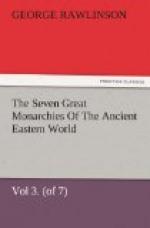[Illustration: PLATE VI.]
The Magian religion was of a highly sacerdotal type. No worshipper could perform any religious act except by the intervention of a priest, or Magus, who stood between him and the divinity as a Mediator. The Magus prepared the victim and slew it, chanted the mystic strain which gave the sacrifice all its force, poured on the ground the propitiatory libation of oil, milk, and honey, held the bundle of thin tamarisk twigs—the Zendic barsom (baregma)—the employment of which was essential to every sacrificial ceremony. The Magi were a priest-caste, apparently holding their office by hereditary succession. They claimed to possess, not only a sacred and mediatorial character, but also supernatural prophetic powers. They explained omens, expounded dreams, and by means of a certain mysterious manipulation of the barsom, or bundle of twigs, arrived at a knowledge of future events, which they communicated to the pious inquirer.
With such pretensions it was natural that the caste should assume a lofty air, a stately dress, and an entourage of ceremonial magnificence. Clad in white robes, and bearing Upon their heads tall felt caps, with long lappets at the sides, which concealed the jaw and even the lips, each with his barsom in his hand, they marched in procession to their pynetheia, or fire altars, and standing around them performed for an hour at a time their magical incantations. The credulous multitude, impressed by sights of this kind, and imposed on by the claims to supernatural power which the Magi advanced, paid them a willing homage; the kings and chiefs consulted them; and when the Arian tribes, pressing westward, came into contact with the races professing the Magian religion, they found a sacerdotal caste all-powerful in most of the Scythic nations.
The original spirit of Zoroastrianism was fierce and exclusive. The early Iranians looked with contempt and hatred on the creed of their Indian brethren; they abhorred idolatry; and were disinclined to tolerate any religion except that which they had themselves worked out. But with the lapse of ages this spirit became softened. Polytheistic creeds are far less jealous than monotheism; and the development of Zoroastrianism had been in a polytheistic direction. By the time that the Zoroastrians were brought into contact with Magism, the first fervor of their religious zeal had abated, and they were in that intermediate condition of religious faith which at once impresses and is impressed, acts upon other systems, and allows itself to be acted upon in return. The result which supervened upon contact with Magism seems to have been a fusion, an absorption into Zoroastrianism of all the chief points of the Magian belief, and all the more remarkable of the Magian religious usages. This absorption appears to have taken place in Media. It was there that the Arian tribes first associated with themselves, and formally adopted into their body,




